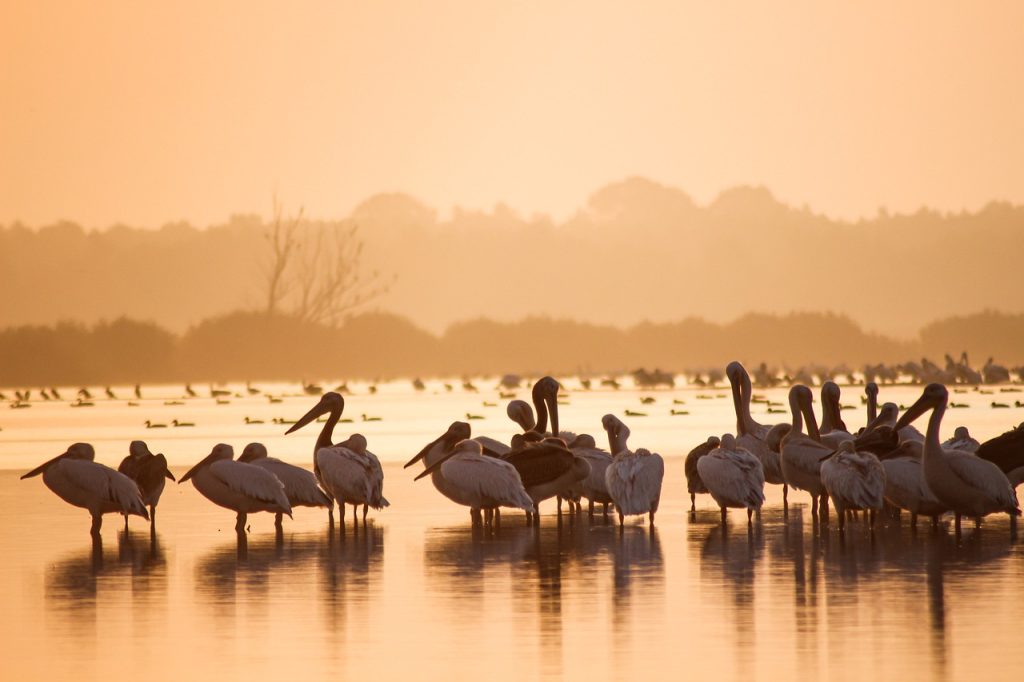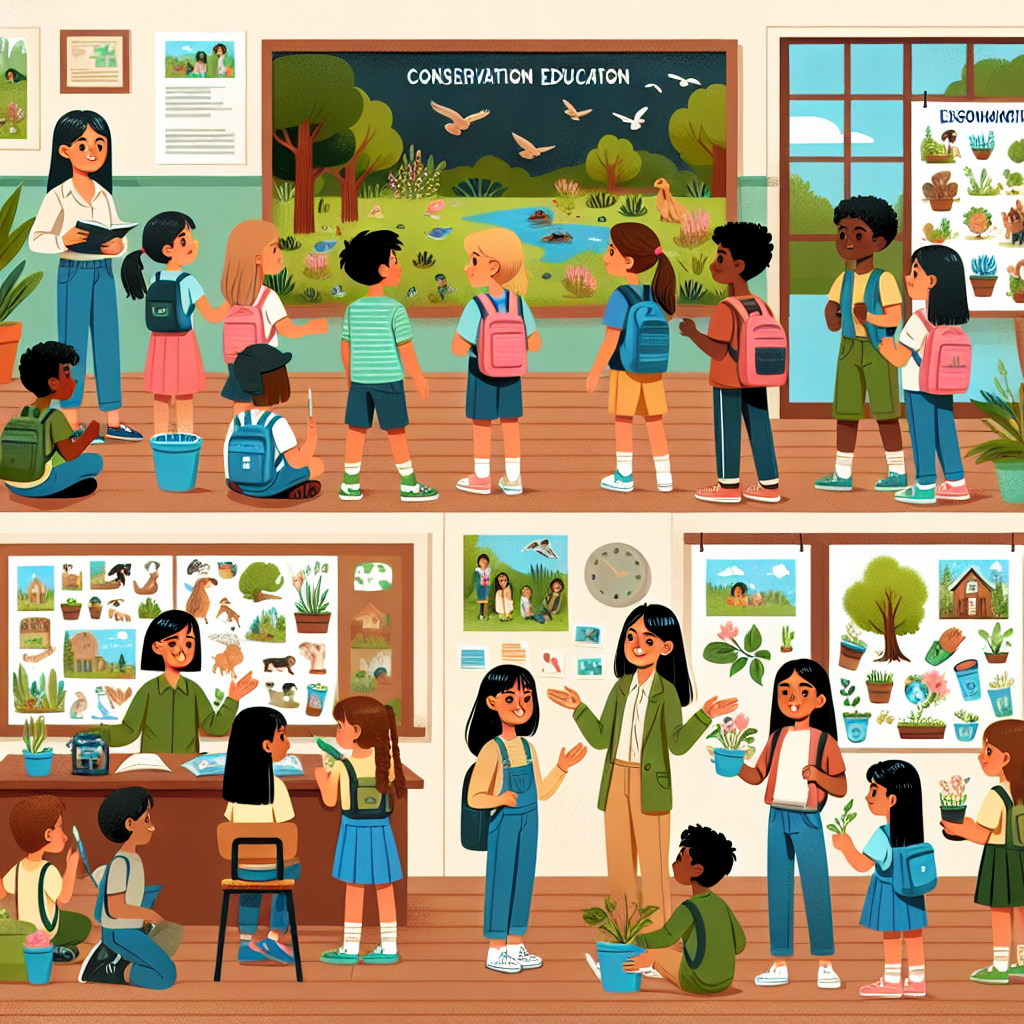Imagine a world where every child has a deep understanding and appreciation for the environment and is actively engaged in conserving it. This ambitious goal can become a reality with the implementation of conservation education in local schools. By introducing students to the importance of environmental preservation at a young age, we have the opportunity to inspire and empower the next generation to become stewards of the planet. Through hands-on experiences, engaging lessons, and interactive activities, conservation education in local schools not only instills valuable knowledge but also cultivates a lifelong passion for protecting our natural world.

What is conservation education?
Conservation education is an approach that promotes the understanding, appreciation, and protection of the natural environment. It aims to raise awareness about conservation issues, instill knowledge and skills related to environmental sustainability, and foster a sense of responsibility towards the Earth. Through conservation education, students learn about the importance of conserving biodiversity, managing natural resources, and mitigating the impacts of human activities on the environment.
The role of local schools in conservation education
Local schools play a vital role in conservation education by serving as platforms for promoting environmental awareness, instilling knowledge and skills, and fostering a sense of responsibility towards the environment. They have the unique opportunity to engage students on a regular basis and provide them with a holistic understanding of conservation issues.
Promoting awareness
Local schools have the power to raise awareness about conservation issues among students. By integrating environmental topics into the curriculum and organizing awareness campaigns, schools can ensure that students are well-informed about the challenges faced by the environment. Awareness creation can include teaching students about endangered species, deforestation, pollution, climate change, and other pressing environmental concerns.
Instilling knowledge and skills
Conservation education equips students with the knowledge and skills needed to become environmentally responsible citizens. By incorporating environmental science into the curriculum, local schools can provide students with a solid foundation in ecological concepts, natural resource management, and sustainability practices. Additionally, students can learn practical skills such as waste reduction, energy conservation, and sustainable farming techniques, which they can apply in their daily lives.
Fostering environmental responsibility
Local schools have the responsibility of cultivating a sense of environmental responsibility among students. By incorporating conservation education into their ethos and values, schools can help students understand their role in preserving and protecting the natural world. Through discussions, projects, and activities, students can develop a deep sense of attachment to the environment and feel compelled to take action to conserve it.
Benefits of conservation education in local schools
Conservation education in local schools offers a wide range of benefits that extend beyond the classroom walls. It not only creates a sustainable future but also empowers youth and builds strong communities.
Creating a sustainable future
One of the primary benefits of conservation education in local schools is the creation of a sustainable future. By teaching students about the importance of conservation, schools help them develop a deep appreciation for the environment and instill in them a sense of responsibility towards its preservation. As these students grow up to become policymakers, scientists, and community leaders, they will be equipped with the knowledge and mindset needed to make informed decisions that contribute to a sustainable future.
Empowering youth
Conservation education empowers youth by giving them the tools and knowledge to address pressing environmental challenges. By engaging students in hands-on activities, field trips, and collaborative projects, schools enable them to become active participants in environmental conservation. This empowerment instills confidence and a sense of agency, making them more likely to take action and make a positive impact on their local communities and beyond.
Building strong communities
Conservation education in local schools fosters a sense of community and collective responsibility. By involving students in environmental initiatives, such as community clean-ups or tree planting events, schools create opportunities for students to work together towards a common goal. These collaborative efforts strengthen community bonds, instill a sense of pride in the local environment, and promote a culture of shared responsibility for its preservation.
Curriculum integration for conservation education
Integrating conservation education into the curriculum is crucial for ensuring that students receive a comprehensive and well-rounded education in environmental conservation. By incorporating environmental science, collaborating across subjects, and emphasizing experiential and outdoor learning, schools can effectively integrate conservation education into their teaching practices.
Incorporating environmental science
Incorporating environmental science into the curriculum allows students to develop a solid understanding of ecological principles, the impacts of human activities on the environment, and the importance of biodiversity conservation. By including topics such as ecosystems, climate change, and sustainable development, schools give students the foundation they need to become environmentally literate.
Collaborating across subjects
Conservation education can be integrated across various subject areas, allowing students to connect their learning to real-world issues. For example, in language arts classes, students can read and discuss literature related to environmental conservation. In social studies classes, they can explore the historical and cultural perspectives on environmental conservation. By collaborating across subjects, schools provide students with a holistic understanding of conservation and encourage them to think critically about the multidimensional aspects of environmental issues.
Experiential and outdoor learning
Experiential and outdoor learning play a crucial role in conservation education. By immersing students in nature and providing hands-on experiences, schools foster a deeper connection to the environment and reinforce the concepts learned in the classroom. Outdoor activities such as field trips, nature excursions, and experiential projects allow students to observe and interact with their natural surroundings, developing a sense of wonder and appreciation for the Earth’s ecosystems.

Engaging teaching methods for conservation education
To effectively engage students in conservation education, teachers can employ various interactive and hands-on teaching methods. By incorporating hands-on activities, organizing field trips and nature excursions, and inviting guest speakers and experts, schools can create dynamic learning experiences that capture students’ interest and enthusiasm.
Hands-on activities
Hands-on activities provide opportunities for students to actively engage with conservation concepts and apply their knowledge. These activities can include building models, conducting experiments, or participating in simulations that demonstrate the impact of human actions on the environment. By providing tangible and practical experiences, schools make conservation education come alive for students, fostering a deeper understanding and appreciation for environmental issues.
Field trips and nature excursions
Field trips and nature excursions allow students to step outside the classroom and immerse themselves in the natural world. By visiting local ecosystems, wildlife sanctuaries, or parks, students can observe firsthand the beauty and complexity of nature. These experiences not only deepen their understanding of conservation but also create lasting memories and a sense of connection to the environment.
Guest speakers and experts
Inviting guest speakers and experts to share their knowledge and experiences can greatly enhance conservation education in local schools. Professionals from environmental organizations, government agencies, or educational institutions can provide valuable insights into conservation efforts, share success stories, and inspire students through their personal stories. These interactions expose students to diverse perspectives, career opportunities, and the impact individuals can have on environmental conservation.
Partnerships between schools and conservation organizations
Partnerships between local schools and conservation organizations are mutually beneficial in advancing conservation education. By collaborating with local environmental non-governmental organizations (NGOs), government agencies, wildlife sanctuaries, and parks, schools gain access to valuable resources, expertise, and experiential learning opportunities.
Local environmental NGOs
Collaborating with local environmental NGOs allows schools to tap into a wealth of expertise and resources related to conservation education. These organizations can provide assistance in curriculum development, offer training for teachers, and facilitate workshops or environmental camps for students. By working together, schools and NGOs can amplify the impact of conservation education, reaching more students and promoting community involvement in conservation efforts.
Government agencies
Government agencies often have dedicated conservation divisions that are involved in education and outreach activities. Schools can form partnerships with these agencies to access educational materials, participate in conservation programs, or engage in policy discussions. Collaboration with government agencies not only strengthens school initiatives but also provides students with insights into the broader systems and policies that shape conservation efforts.
Wildlife sanctuaries and parks
Collaboration with wildlife sanctuaries and parks allows schools to provide students with unique outdoor learning experiences. These protected areas offer opportunities for students to observe wildlife, learn about biodiversity conservation, and understand the importance of habitat preservation. Partnerships with sanctuaries and parks can include guided tours, workshops, or joint research projects, enriching students’ understanding of conservation issues.

Inspiring student involvement in conservation
To inspire student involvement in conservation, schools can create opportunities for students to actively participate in environmental initiatives. By establishing student-led environmental clubs, organizing awareness campaigns, and engaging in community service projects, schools empower students to become change-makers and advocates for the environment.
Student-led environmental clubs
Student-led environmental clubs offer a platform for students to come together and engage in conservation activities. These clubs can organize awareness campaigns, community clean-ups, tree-planting drives, or other initiatives that promote environmental stewardship. By empowering students to take ownership of these clubs, schools cultivate student leadership skills, environmental advocacy, and a sense of responsibility towards their surroundings.
Environmental awareness campaigns
Organizing environmental awareness campaigns within the school community raises consciousness about conservation issues and encourages behavioral changes. These campaigns can include workshops, seminars, or competitions that foster discussions, encourage sustainable practices, and promote informed decision-making. By involving students, teachers, and parents, schools foster a sense of collective responsibility and promote environmentally-friendly behaviors.
Community service projects
Engaging in community service projects allows students to actively contribute to conservation efforts in their local communities. Schools can collaborate with local organizations or community groups to identify and address environmental challenges. Students can participate in projects such as constructing community gardens, organizing recycling programs, or restoring local ecosystems. By engaging students in hands-on conservation work, schools foster a sense of civic duty and empower students to make a tangible impact.
Equity and access in conservation education
Ensuring equity and access to conservation education is essential to address socio-economic disparities and provide equal opportunities for all students. By recognizing and overcoming barriers such as limited resources, cultural biases, or geographic constraints, schools can foster inclusivity and make conservation education accessible to all.
Addressing socio-economic disparities
Schools need to address socio-economic disparities to ensure that all students have access to conservation education. This can be achieved by providing financial assistance for students to participate in field trips or nature excursions, offering scholarships for environmental science programs, or establishing partnerships with local businesses or organizations to sponsor conservation education initiatives. By addressing these disparities, schools can bridge the gap and provide equal opportunities for all students to engage in conservation education.
Providing equal opportunities
Inclusive conservation education requires providing equal opportunities for all students, regardless of their cultural or ethnic backgrounds. Schools can achieve this by ensuring that the curriculum reflects diverse perspectives and cultures. Additionally, teachers can create a supportive and inclusive classroom environment that values and respects different cultural beliefs and practices. By embracing diversity, schools create a nurturing space where all students feel valued and included in conservation education.
Ensuring inclusivity
Schools must recognize and overcome geographic constraints to ensure inclusivity in conservation education. This can involve leveraging technology to provide virtual field trips or online resources for students in remote areas. Schools can also establish partnerships with conservation organizations to bring their expertise and resources directly to schools located in geographically isolated regions. By adopting innovative approaches, schools can ensure that students from all backgrounds and locations have the opportunity to engage in conservation education.

Assessing the effectiveness of conservation education
Assessing the effectiveness of conservation education is crucial to ensure that the intended learning outcomes are achieved. By measuring knowledge and awareness, evaluating behavioral changes, and conducting long-term impact assessments, schools can continuously improve their conservation education programs.
Measuring knowledge and awareness
Knowledge and awareness assessments enable schools to gauge students’ understanding of conservation concepts and the effectiveness of their teaching methods. These assessments can take the form of quizzes, tests, or projects that require students to demonstrate their knowledge of ecological principles, conservation practices, or environmental challenges. By regularly evaluating knowledge and awareness levels, schools can identify areas for improvement and adjust their teaching strategies accordingly.
Evaluating behavioral changes
Assessing behavioral changes allows schools to determine whether conservation education initiatives translate into real-world actions and sustainable behaviors. Surveys, interviews, or observation of students’ environmentally-friendly actions can help schools measure behavioral changes. For example, schools can assess whether students practice energy conservation, reduce waste, or participate in community conservation initiatives. By analyzing these behavioral changes, schools can determine the effectiveness of their conservation education programs in influencing students’ actions.
Long-term impact assessment
Long-term impact assessments are essential to determine the lasting effects of conservation education on students’ attitudes and behaviors. These assessments can be conducted through follow-up surveys or alumni studies to track the long-term engagement of students in environmental activities. By studying alumni who have completed the conservation education program, schools can gain insights into the program’s impact on career choices, environmental advocacy, and overall attitudes towards conservation. Long-term impact assessments provide valuable feedback for schools to refine and improve their conservation education initiatives.
Success stories in conservation education
Numerous success stories highlight the positive impact of conservation education in local schools. These stories showcase impactful programs, noteworthy student achievements, and recognition and awards that acknowledge the efforts of schools and students in conservation education.
Case studies of impactful programs
Case studies of impactful programs demonstrate how conservation education has made a difference in local schools. These programs can range from school-led initiatives focused on biodiversity conservation to collaborations with external organizations for community-based conservation projects. By studying these case studies, schools can gain inspiration and insights into effective strategies for implementing conservation education.
Noteworthy student achievements
Noteworthy student achievements in conservation education serve as inspirations and demonstrate the potential of young individuals to make a difference. These achievements can include research projects, community service initiatives, or individual actions that have had a positive impact on the environment. By recognizing and celebrating these achievements, schools motivate other students to get involved in conservation efforts and inspire them to make their mark.
Recognition and awards
Recognition and awards for conservation education initiatives validate the efforts of schools and students. These accolades can come from local, national, or international organizations that value the importance of conservation education. Such recognition not only reinforces the importance of conservation education but also provides schools and students with encouragement and motivation to continue their conservation efforts.
In conclusion, conservation education in local schools is a powerful tool for inspiring the next generation of environmental stewards. By promoting awareness, instilling knowledge and skills, and fostering a sense of environmental responsibility, local schools play a crucial role in shaping the mindset and actions of students towards environmental conservation. Integration of conservation education into the curriculum, engagement through hands-on activities and outdoor learning, partnerships with conservation organizations, and student involvement in conservation initiatives all contribute to creating a more sustainable future. With equality, access, and assessment in mind, local schools have the opportunity to empower youth, build strong communities, and leave a lasting impact on the conservation movement.


